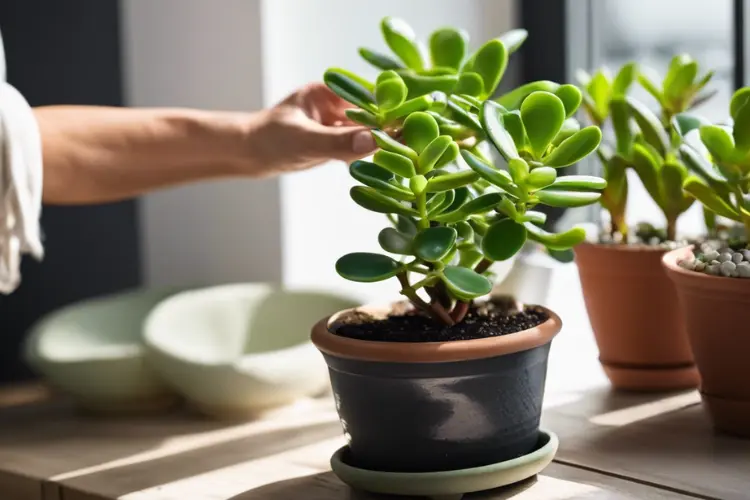
The Complete Guide to Growing and Caring for Jade Plants
The jade plant can be grown indoors or outdoors, irrespective of your gardening skill level, thanks to its hardiness and low maintenance requirements.
Share This Post!
Jade plants are perennial favorites among plant enthusiasts, with their vibrant green leaves and coin-shaped leaves. Many cultures refer to these succulents as symbols of prosperity and good luck because of their longevity and resilience.
Additionally, jade plants do a great job of purifying the air, making them a great addition to any room.
What Are Jade Plants, and Why Should You Grow Them?
Originally native to South Africa, jade plants are succulents, specifically the Crassulaceae family. They are known botanically by Crassula ovata — ‘Crassula’ comes from the Latin word “crassus”, meaning thick, and ‘ovata’ for their rounded leaves.
| Common Name | Jade plant |
|---|---|
| Botanical Name | Crassula ovata |
| Other Names |
|
| Family | Crassulaceae/Stonecrops |
| Max. Height | 5-6 ft. |
| Poison Property | Mildly toxic if ingested For Pets |
Find out why adding a jade plant to your space could be a rewarding choice.
The Benefits of Jade Plants
Good Luck Charm:
In Feng Shui, jade plants are often associated with good luck, wealth, and prosperity.
Air Purifiers:
Like many succulents, they can help purify the air in your home, removing toxins such as formaldehyde.
Great for Beginners:
Their easy-care nature makes them an ideal starter plant for novice gardeners.
Symbolism:
It’s said that the plant attracts prosperity because its five-petaled flowers symbolize the five good fortunes.
Getting Started with Jade Plants
Jade plants grow easily in hot and arid environments, which are characteristic of their native habitat. Gardeners who grow these plants at home need little maintenance because of their preference for dry, well-drained soil and infrequent watering.
Choosing the Right Pot and Soil:
Ensure the pot has drainage holes in order to prevent root rot. The larger the pot, the more space it will have for the plant’s eventual growth.
For the soil, a well-draining mix tailored to cacti and succulents is ideal. A mixture of equal parts of potting soil, sand, and perlite can also be made if you want better drainage.
Understanding Sunlight and Watering Needs:
Jade plants hunger for sunlight, typically thriving in direct sunlight for at least four hours a day.
When it comes to watering, the golden rule is to wait until the soil is fully dry between watering sessions, which usually means about once every 2-3 weeks. Overwatering can be fatal for jade plants.
Propagating Jade Plants
Grow Jade plant Using Stem:
Propagation By Using Leaves:
Re-Potting Jade Plant
When a jade plant becomes younger enough that the current pot is no more according to its size, it’s time for repotting this lucky plant. Warm-season is the best time of repotting.
For repoting, wait to dry out the soil thoroughly. When you confirmed about its dry condition, put it out from the current pot, don’t use the old soil, cut the dead or fungicide roots. After that place it carefully in a new one which is perfect according to its size.
Don’t water & fertilize it immediately, wait for 5 to 7 days. After that water jade plant slowly to reduce the risk of root rot.
Caring for Your Jade Plant
In order to properly care for your jade plant, you need to follow a few simple but important steps.
Pruning and Shaping Jade Plants:
Pruning regularly can help plants grow bushier and fuller. Keeping your jade healthy requires cutting back long, leggy growth and removing diseased or damaged foliage.
Fertilizing Jade Plants
In order to maintain good health, jade plants require a balanced houseplant fertilizer that has been diluted to half strength.
You should apply this once every six months, typically in spring and summer. Overfertilizing can cause excessive, weak growth.
Dealing with Common Pests and Diseases
Jade plants are robust but not immune to problems. Keep an eye out for signs of pests such as mealybugs or spider mites.
You can remove pest infestations by isolating the plant and using an organic pesticide, or washing it with soapy water.
Tips for Successful Jade Plant Care
In order to properly care for your jade plant, you need to follow a few simple but important steps.
Pruning and Shaping Jade Plants:
Pruning regularly can help plants grow bushier and fuller. Keeping your jade healthy requires cutting back long, leggy growth and removing diseased or damaged foliage.
Fertilizing Jade Plants
In order to maintain good health, jade plants require a balanced houseplant fertilizer that has been diluted to half strength.
You should apply this once every six months, typically in spring and summer. Overfertilizing can cause excessive, weak growth.
Dealing with Common Pests and Diseases
Jade plants are robust but not immune to problems. Keep an eye out for signs of pests such as mealybugs or spider mites.
You can remove pest infestations by isolating the plant and using an organic pesticide, or washing it with soapy water.
